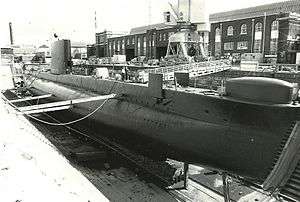HMS Osiris (S13)
HMS Osiris (S13) was an Oberon-class submarine that served in the Royal Navy.
 HMS Osiris at Portsmouth Navy Days, August 1982 | |
| History | |
|---|---|
| Name: | HMS Osiris |
| Namesake: | Osiris |
| Builder: | Vickers-Armstrongs at Barrow-in-Furness |
| Laid down: | 26 January 1962 |
| Launched: | 29 November 1962 |
| Commissioned: | 11 January 1964 |
| Decommissioned: | 1989 |
| Fate: | sold to Canadian Forces, 1989 |
| Badge: | Blazon azure with the profile of Osiris |
| Acquired: | 1989, for spare parts |
| Fate: | scrapped, 1991 |
| General characteristics as designed | |
| Class and type: | Oberon class |
| Displacement: |
|
| Length: |
|
| Beam: | 26.5 feet (8.1 m) |
| Draught: | 18 feet (5.5 m) |
| Propulsion: |
|
| Speed: |
|
| Complement: | 68 (6 officers, 62 enlisted) |
| Sensors and processing systems: |
|
| Armament: |
|
Design and construction
The Oberon class was a direct follow on of the Porpoise class, with the same dimensions and external design, but updates to equipment and internal fittings, and a higher grade of steel used for fabrication of the pressure hull.[1]
As designed for British service, the Oberon-class submarines were 241 feet (73 m) in length between perpendiculars and 295.2 feet (90.0 m) in length overall, with a beam of 26.5 feet (8.1 m), and a draught of 18 feet (5.5 m).[2] Displacement was 1,610 tons standard, 2,030 tons full load when surfaced, and 2,410 tons full load when submerged.[2] Propulsion machinery consisted of 2 Admiralty Standard Range 16 VMS diesel generators, and two 3,000 shaft horsepower (2,200 kW) electric motors, each driving a 7-foot diameter (2.1 m) 3-bladed propeller at up to 400 rpm.[2] Top speed was 17 knots (31 km/h; 20 mph) when submerged, and 12 knots (22 km/h; 14 mph) on the surface.[2] Eight 21-inch (530 mm) diameter torpedo tubes were fitted (six facing forward, two aft), with a total payload of 24 torpedoes.[2] The boats were fitted with Type 186 and Type 187 sonars, and an I-band surface search radar.[2] The standard complement was 68: 6 officers, 62 sailors.[2]
Osiris was laid down by Vickers-Armstrongs on 26 January 1962, and launched on 29 November 1962.[2] The boat was commissioned into the Royal Navy on 11 January 1964.[2]
Operational history
Osiris attended the 1977 Silver Jubilee Fleet Review off Spithead when she was part of the Submarine Flotilla.[3]
Decommissioning and fate
She was decommissioned and sold to the Canadian Forces in 1989 for spare parts, towed to Birkenhead on the River Mersey where Cammell Laird shipyard completed the stripping out. In August 1991, the remains were moved to Garston for final demolition and scrapped in 1992.
References
- Chant, Christopher (2005). Submarine Warfare Today: The World's Deadliest Underwater Weapons Systems. Wigston: Silverdale Books. p. . ISBN 1-84509-158-2. OCLC 156749009.
- Moore, John, ed. (1977). Jane's Fighting Ships 1977–78. Jane's Fighting Ships (80th ed.). London: Jane's Yearbooks. p. 490. ISBN 0531032779. OCLC 18207174.
- Official Souvenir Programme, 1977. Silver Jubilee Fleet Review, HMSO
Publications
- Colledge, J. J.; Warlow, Ben (2006) [1969]. Ships of the Royal Navy: The Complete Record of all Fighting Ships of the Royal Navy (Rev. ed.). London: Chatham Publishing. ISBN 978-1-86176-281-8.